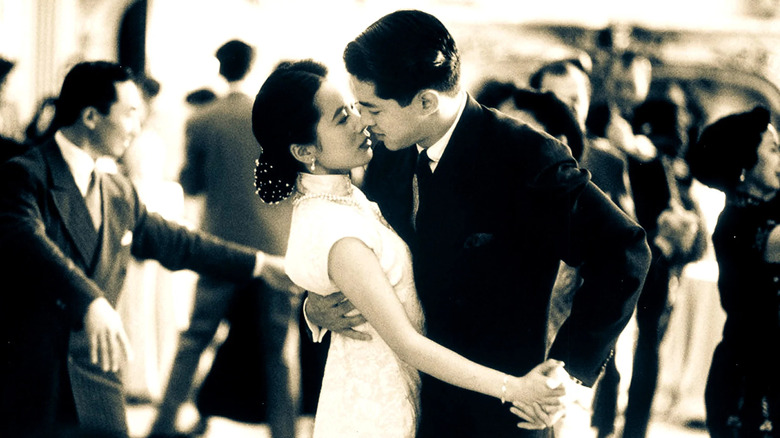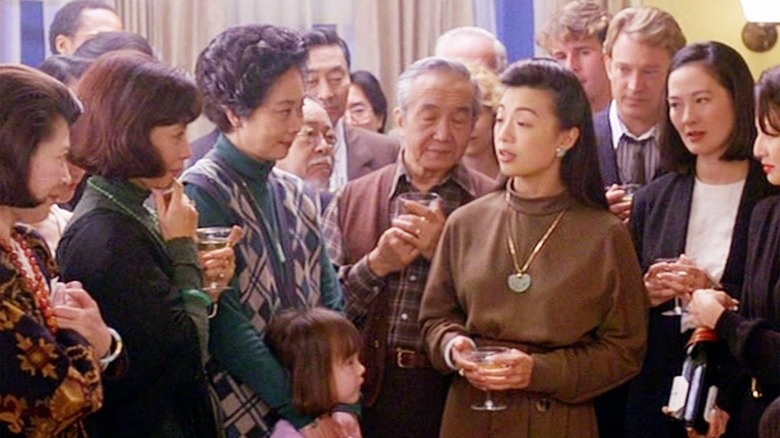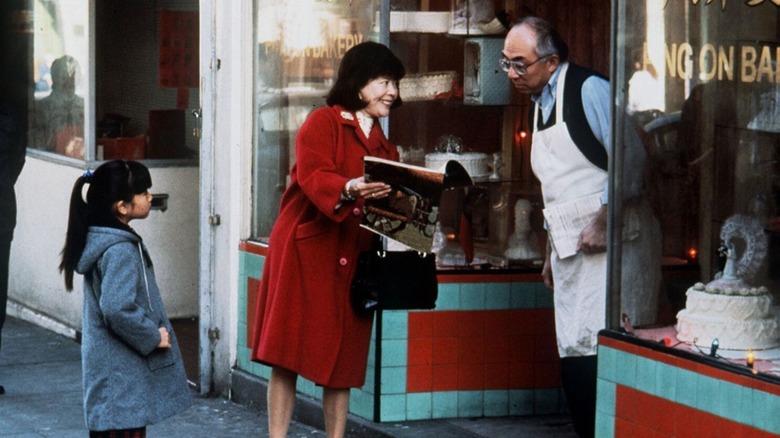It Took A Unique Screenwriting Approach To Keep The Joy Luck Club's Stories Intact
The fact that "The Joy Luck Club" was made is really a miracle in itself. The film that The Hollywood Reporter called "25 years too early" examines the culture clash between four Asian-American women and their mothers. The film is based on Amy Tan's 1989 novel and presents a complex narrative that follows the interwoven lives of four families and their heritage.
Selling an Asian-American project in Hollywood in the early 1990s was an uphill climb. Unheard of, really. And even after it was made, it took more than two decades for another film with an all Asian-American cast to be made in Hollywood with "Crazy Rich Asians" in 2018.
And then there was the issue of eight major characters to track in the film's narrative. But Tan and screenwriter Ron Bass set out to carve out a creative screenplay that would keep all eight characters intact while telling the story of Asian-American women finding their worth in modern-day America.
'You have all these people and their stories interlock'
Tan's novel, which was on the New York Times best-seller list and peaked at #1, is 16 chapters of intricate details about three generations of four Chinese families. So, she expected that a lot of the details — and maybe even characters — would have to be trimmed or cut altogether for a movie. According to Buzzfeed, Bass realized that the complex narrative was precisely what made the novel so good, and the characters and family history would all need to stay. In their first meeting, Bass told Tan:
"That's the whole point of it – You have all these people, and their stories interlock...It makes a tapestry of all human nature."
The two pored over the novel and Bass wrote a screenplay that seamlessly moves from family to family, focusing on the past and how those experiences impacted present-day relationships. The different eras juxtapose each family's roots and the modern Asian-American experience. The film's structure of four parts with four sequences in each mirrors the rounds and hands in a game of mahjong. In the movie, mahjong games serve as a plot device to bring the older generation together.
This non-linear structure reveals the conflict between mothers and daughters. An example of this on-screen is when an ancestor raised in China ritualistically slices off a piece of her flesh to put in a soup for her ailing mother, followed by a cut to the present day where the ancestor's granddaughter carelessly tosses diner soup into the trash. It is a visual metaphor for the younger generation not knowing or caring about the traditions of their ancestors.
But before filming could begin, the project needed to be funded. Once the screenplay was completed and director Wayne Wang was attached, the project still couldn't gain any traction. Then, a big name in Hollywood stepped up to lend a hand.
No Stone unturned in looking for help
Legendary director and producer Oliver Stone is not afraid to take risks. In 1991 he produced and directed the groundbreaking female road trip movie "Thelma & Louise" when no one else in Hollywood would touch it. The script for "The Joy Luck Club" eventually made its way to Stone's production company. The timing of the project wasn't right for Stone, but he offered to attach his name to the film as executive producer.
Even with Stone connected to the project, only one studio agreed to produce the film: Disney's Hollywood Pictures. "The Joy Luck Club" also exposed the lack of Asian-American talent in Hollywood during the casting process. Once the project was greenlit, they struggled to cast eight Chinese actors in the leading roles and eventually conceded to cast non-Chinese actors for the roles.
Part of what makes "The Joy Luck Club" so special is that it moves away from the typical Hollywood stereotypes of Asians as mystical, mysterious, and sensual. Think Mr. Miyagi in "The Karate Kid," who appears from the mist to save Daniel and later heals him with his bare hands using some unknown power. Instead, these are deeply personal stories filled with raw emotion from fully formed Asian-American female characters.
The stories also resonated with audiences. "The Joy Luck Club" grossed nearly $33 million at the box office, per Box Office Mojo, despite a limited theatrical release. Unfortunately, the success of "The Joy Luck Club" did not create a new template for Asian-American representation in cinema, and we've had to wait a long time for another film like it. The film's legacy shows that complex Asian-American stories can be told in Hollywood and connect with audiences, even if Hollywood wasn't ready.


